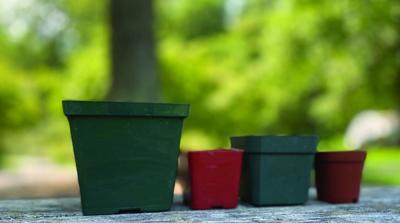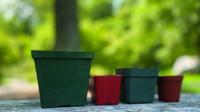Trade associations within the nursery and landscape businesses like to promote themselves as “the green industry,” but sometimes what we do as gardeners is not so green. For example, in 2009, the lasts year for which Marie Chieppo has figures, growers in the United States used 1.66 billion pounds of plastic in the form, mostly of plastic pots.
You might think that, given the green-ness of our industry, the majority of these pots might be recycled, but again according to Marie Chieppo and the report on plastic nursery containers that she wrote for the APLD, the Association of Professional Landscape Designers, that is not the case. Some 95 percent of the plastic containers used by the horticultural industry are disposed of in the landfill, which is why 90 percent of the containers in any given year are produced from “virgin” feedstock, new petroleum pumped fresh from the ground.
When I spoke to Marie Chieppo about this topic recently, she told me about some of the obstacles to the recycling of plastic nursery pots. This is a subject close to her heart, as after starting her career as a researcher for The New England Journal of Medicine, Marie turned her passion into her profession 23 years ago and trained as a designer of ecologically based landscapes and gardens (she is the principal at EcoPlantPlans LLC). She’s a Certified Massachusetts Master Gardener, a Certified Garden Designer, and a Certified Native Plant Designer.
The obstacles to recycling of plastic nursery containers are many. When emptied of their plants by the gardener or landscaper, the pots are almost certainly dirty and have to be scrubbed out before they are candidates for recycling. A limited number of nurseries will take their containers back and try to re-use them for next year’s crops. Most growers, however, want fresh-from-the-factory pots, and for this the used pots must be re-processed. Many of the containers are made of lower-grade resins, which cannot be re-processed successfully, and even those that are made of high-density polyethylene (HDPE -2) can only be re-processed once or twice. Further complicating this process is the fact that most of the plastic plant containers are black, and the optical scanners standard at recycling centers cannot read the recycling codes stamped into black plastic and so those pots are automatically discarded.
There are better alternatives, Marie Chieppo stresses. There are, for example, bioplastic plant containers, and although they contain some petroleum products, much of their plastic is derived from biomass sources. When ready to be discarded, bioplastic pots can be bio-degraded successfully by industrial composting systems. Even more eco-friendly are so-called compostable pots, which are made entirely from bio-degradable materials such as wood fiber. Compostable pots can be bio-degraded in virtually any composting set-up including home heaps.
Finally, there are also plantable pots, such as those made of compressed peat or “Cow Pots” which are made of processed cow manure. These last allow planting without the removal of the pot, as they will decompose in place and actually add a modest amount of desirable organic material to the garden soil.
There are a number of factors that discourage growers from switching to these environmentally more desirable containers. One is familiarity: the growers are used to the disposable plastic containers they presently use and know how to make them work. Likewise, the durability of these containers, a problem when it comes to their disposal, makes them appealing to growers who may be shipping their plants long distances. As Marie Chieppo suggests, the industry will need encouragement to make this change.
For landscape professionals, one way to apply pressure is to go to the APLD’s web page, “Healthy Pots, Healthy Planet” (https://www.apld.org/healthy-pots-healthy-planet/) and register to join its growing list of designers and design firms demanding change. Chieppo also suggests that designers specify the use of recyclable or compostable pots in their designs. This, of course, is something that gardeners can also do. We, too, can request at our local garden centers or big box stores that they switch to greener plant containers, and make a point of patronizing businesses that have done so. As in so many other aspects of the current environmental crisis, collaborative action is essential, but responsibility ultimately is personal: you and I must make our choices and take action accordingly.
For more information about this subject, listen to a conversation with Marie Chieppo on the Berkshire Botanical Garden’s Growing Greener podcast at https://www.thomaschristophergardens.com/podcasts/the-environmental-cost-of-plastic-nursery-pots-and-promoting-the-alternatives.
Be-a-Better-Gardener is a community service of Berkshire Botanical Garden, located in Stockbridge, Mass. Its mission, to provide knowledge of gardening and the environment through a diverse range of classes and programs, informs and inspires thousands of students and visitors each year. Thomas Christopher is a volunteer at Berkshire Botanical Garden and is the author or co-author of more than a dozen books.









